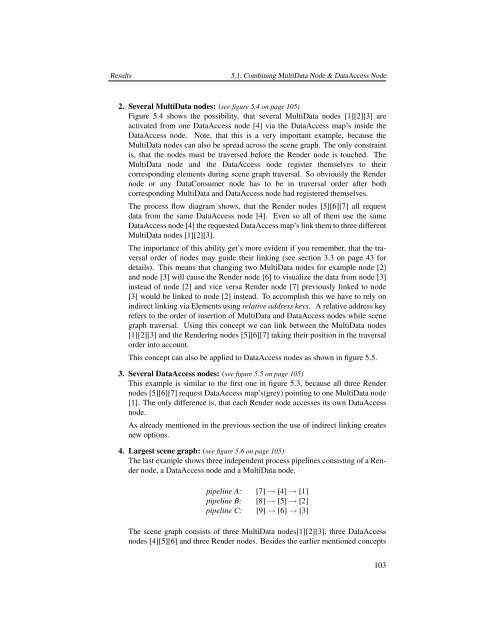CashFlow, A Visualization Framework for 3D Flow - Studierstube ...
CashFlow, A Visualization Framework for 3D Flow - Studierstube ...
CashFlow, A Visualization Framework for 3D Flow - Studierstube ...
- No tags were found...
Create successful ePaper yourself
Turn your PDF publications into a flip-book with our unique Google optimized e-Paper software.
Results5.1. Combining MultiData Node & DataAccess Node2. Several MultiData nodes: (see figure 5.4 on page 105)Figure 5.4 shows the possibility, that several MultiData nodes [1][2][3] areactivated from one DataAccess node [4] via the DataAccess map’s inside theDataAccess node. Note, that this is a very important example, because theMultiData nodes can also be spread across the scene graph. The only constraintis, that the nodes must be traversed be<strong>for</strong>e the Render node is touched. TheMultiData node and the DataAccess node register themselves to theircorresponding elements during scene graph traversal. So obviously the Rendernode or any DataConsumer node has to be in traversal order after bothcorresponding MultiData and DataAccess node had registered themselves.The process flow diagram shows, that the Render nodes [5][6][7] all requestdata from the same DataAccess node [4]. Even so all of them use the sameDataAccess node [4] the requested DataAccess map’s link them to three differentMultiData nodes [1][2][3].The importance of this ability get’s more evident if you remember, that the traversalorder of nodes may guide their linking (see section 3.3 on page 43 <strong>for</strong>details). This means that changing two MultiData nodes <strong>for</strong> example node [2]and node [3] will cause the Render node [6] to visualize the data from node [3]instead of node [2] and vice versa Render node [7] previously linked to node[3] would be linked to node [2] instead. To accomplish this we have to rely onindirect linking via Elements using relative address keys. A relative address keyrefers to the order of insertion of MultiData and DataAccess nodes while scenegraph traversal. Using this concept we can link between the MultiData nodes[1][2][3] and the Rendering nodes [5][6][7] taking their position in the traversalorder into account.This concept can also be applied to DataAccess nodes as shown in figure 5.5.3. Several DataAccess nodes: (see figure 5.5 on page 105)This example is similar to the first one in figure 5.3, because all three Rendernodes [5][6][7] request DataAccess map’s(grey) pointing to one MultiData node[1]. The only difference is, that each Render node accesses its own DataAccessnode.As already mentioned in the previous section the use of indirect linking createsnew options.4. Largest scene graph: (see figure 5.6 on page 105)The last example shows three independent process pipelines consisting of a Rendernode, a DataAccess node and a MultiData node.pipeline A: [7] → [4] → [1]pipeline B: [8] → [5] → [2]pipeline C: [9] → [6] → [3]The scene graph consists of three MultiData nodes[1][2][3], three DataAccessnodes [4][5][6] and three Render nodes. Besides the earlier mentioned concepts103





